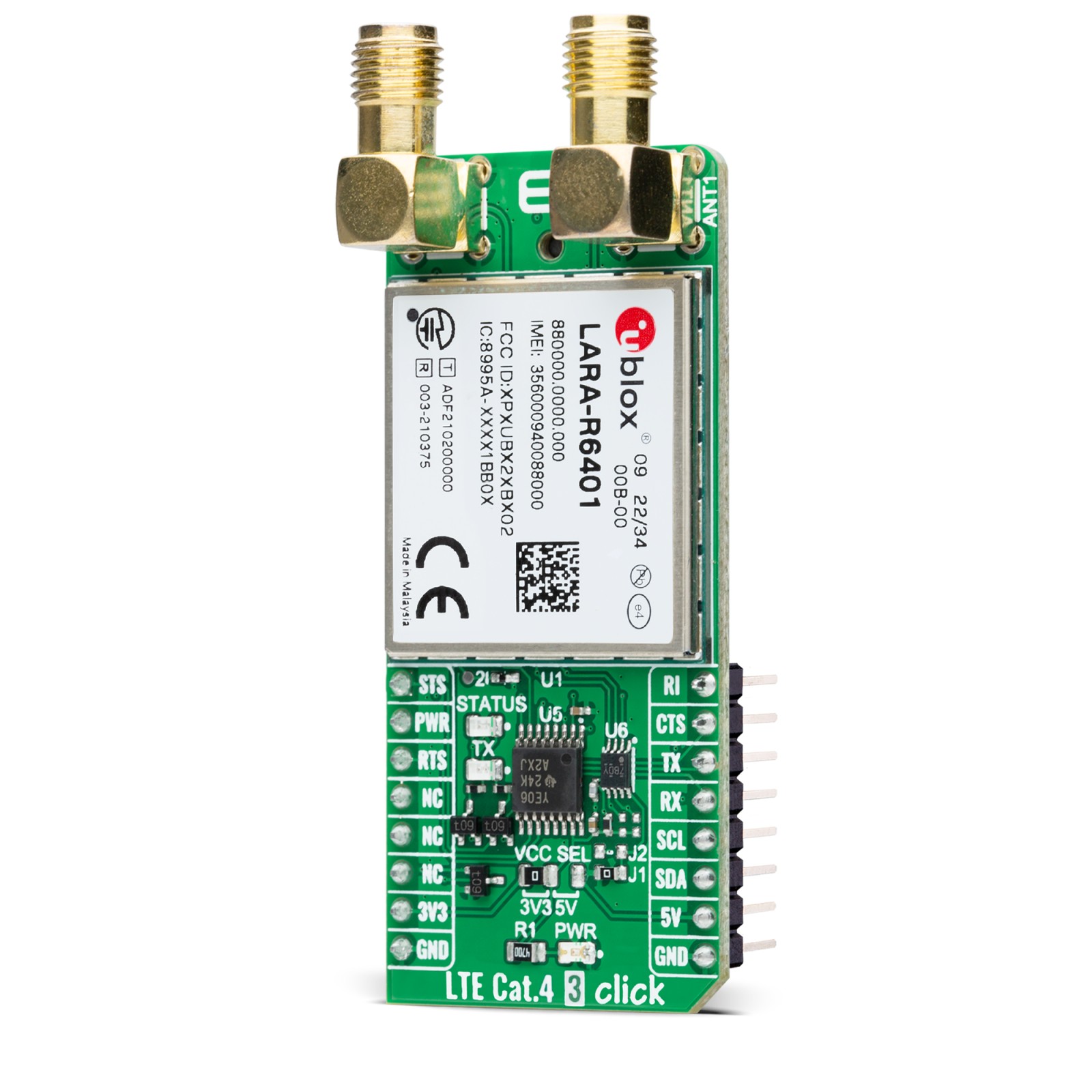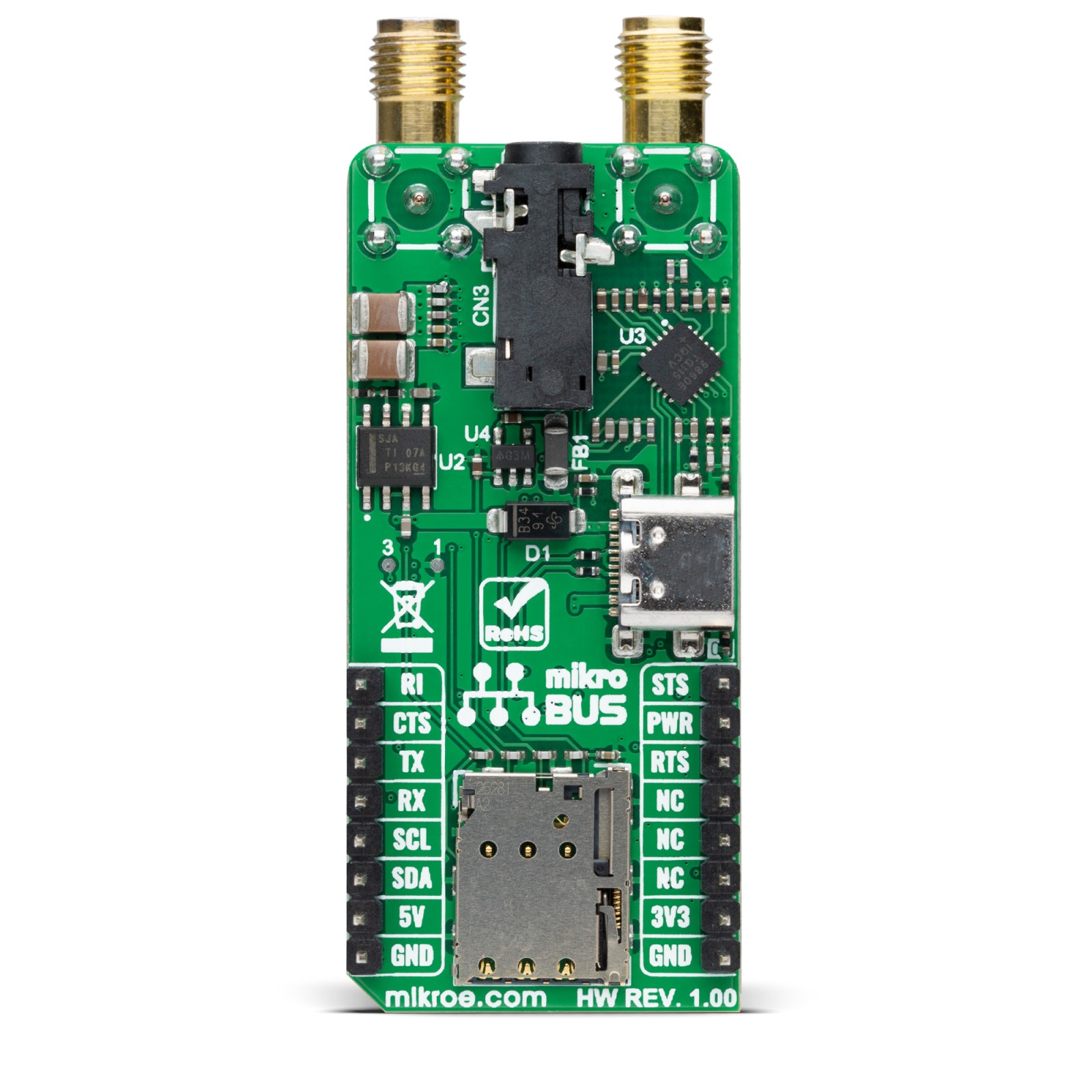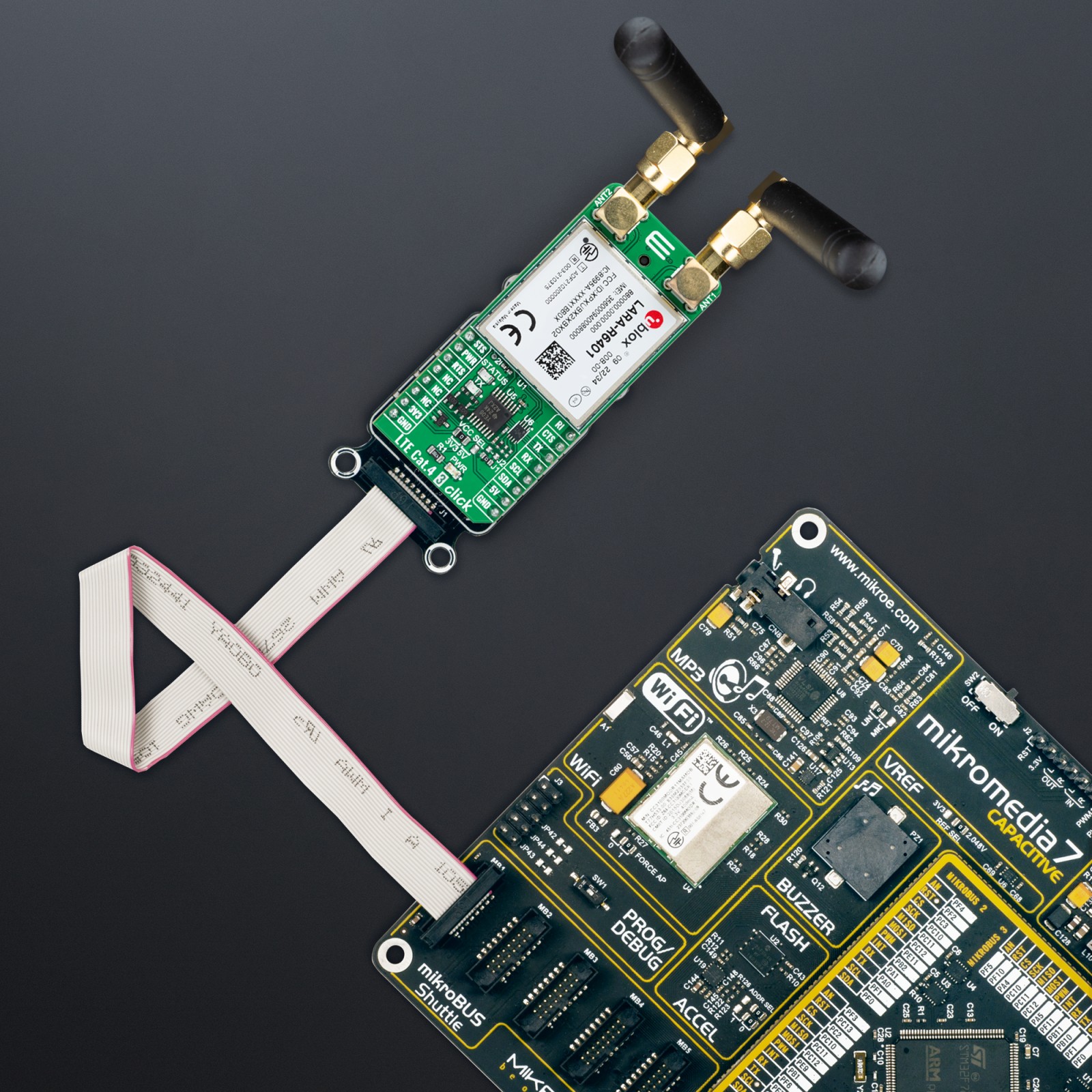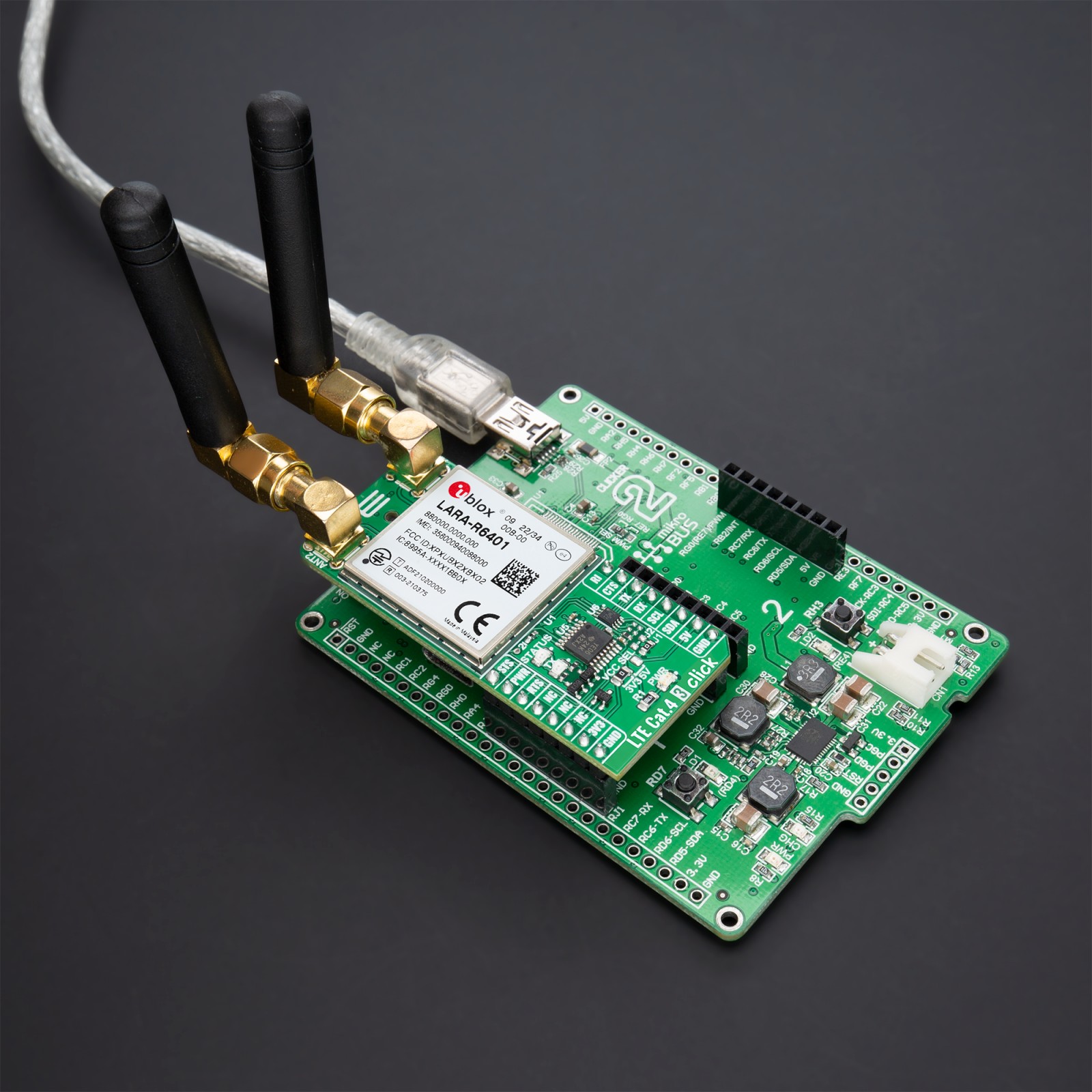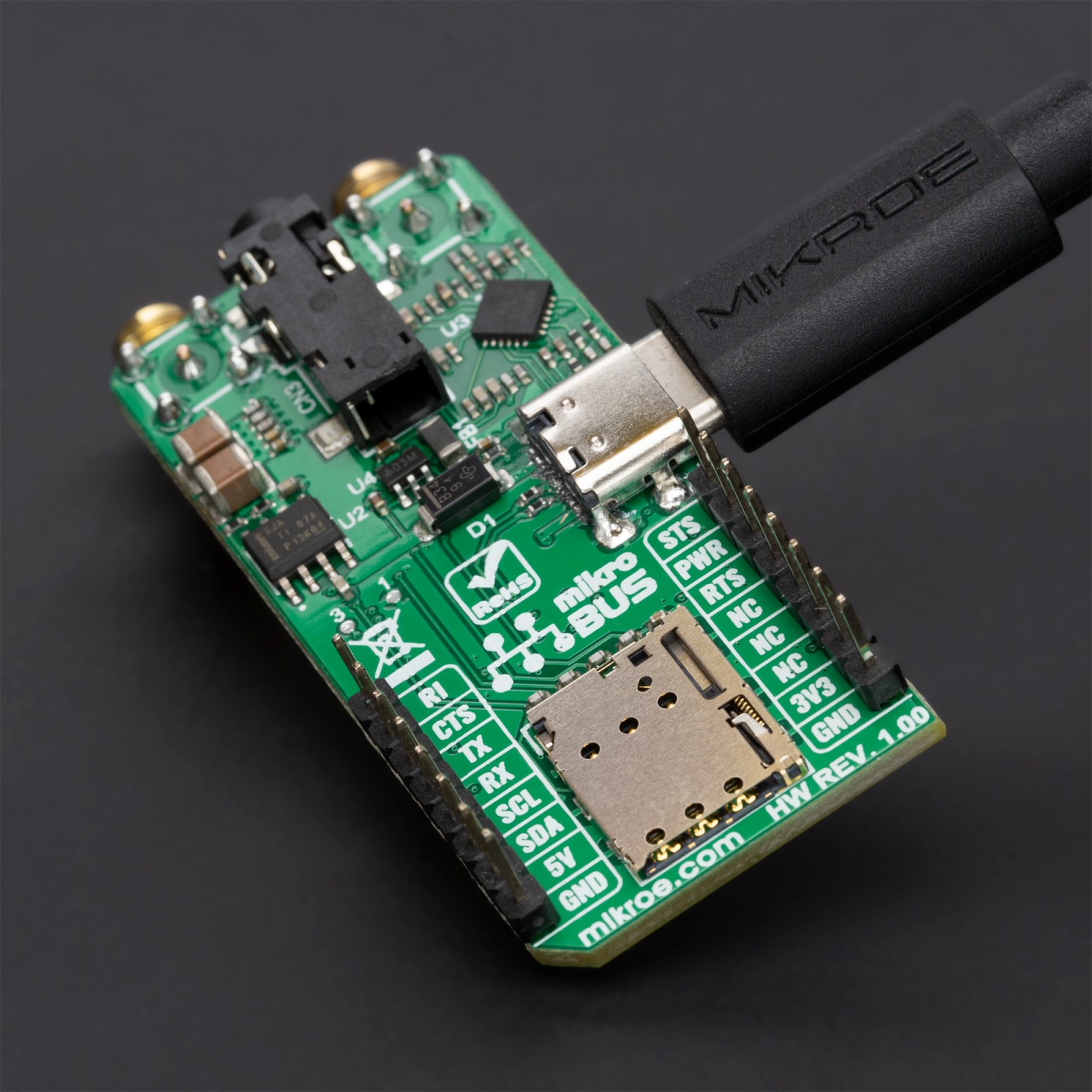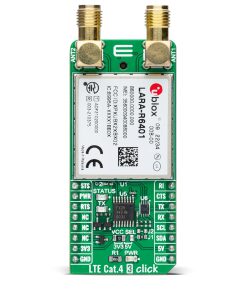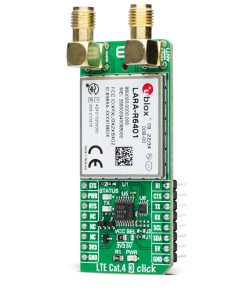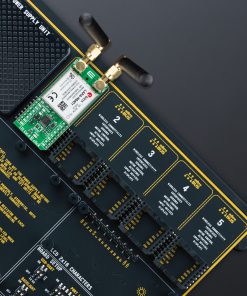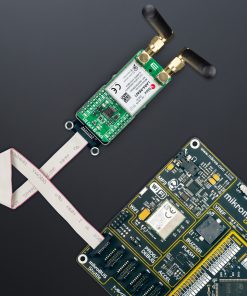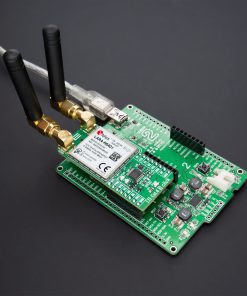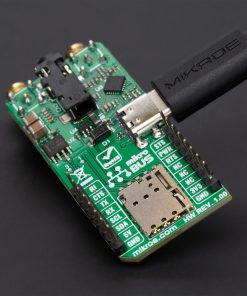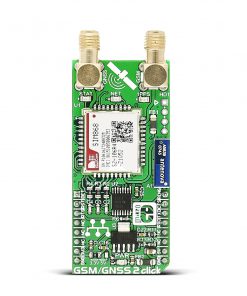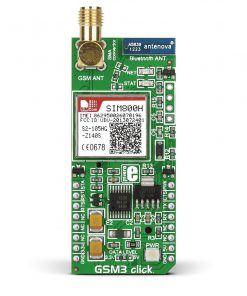LTE Cat.4 3 Click – Data
R2,600.00 ex. VAT
LTE Cat.4 3 Click is a compact add-on board representing a multi-band and multi-mode solution, offering universal connectivity and reliable performance. This board features the LARA-L6004D-01B, an LTE Cat 4 module in the smallest form factor from u-blox. The module supports an LTE Cat 4 FDD and an LTE Cat 4 TDD radio access technology (RAT), with a 3G UMTS/HSPA and 2G GSM/GPRS/EGPRS fallback. It is an ideal solution for global and multi-regional coverage. This Click board™ makes the perfect solution for the development of asset tracking, telematics, remote monitoring, alarm panels, video surveillance, and more.
LTE Cat.4 3 Click is supported by a mikroSDK compliant library, which includes functions that simplify software development. This Click board™ comes as a fully tested product, ready to be used on a system equipped with the mikroBUS™ socket.
Stock: Lead-time applicable.
| 5+ | R2,470.00 |
| 10+ | R2,405.00 |
| 15+ | R2,340.00 |
| 20+ | R2,275.00 |
How does it work?
LTE Cat.4 3 Click is based on the LARA-L6004D-01B, an LTE Cat 4 module in the smallest form factor from u-blox. This data-only module supports DualStack IPv4/IPv6, FOAT/uFOTA, LwM2M, jamming detection, and more. It operates as a four-band device in a frequency range of 700MHz up to 2600MHz. There are two SMA antenna connectors to which you should connect the appropriate antennas that MIKROE offers. The ANT1 antenna is a primary one that supports both TX and RX, while the ANT2 one only supports RX for the LTE Down-Link MIMO 2×2 and 3G RX diversity configuration.
.jpg)
The LTE Cat.4 3 Click is equipped with a nano SIM card holder for both 1.8V and 3.0V SIM types. The module also includes a USB high-speed 2.0-compliant interface with a minimum 480Mbps data rate. The module itself acts as a USB device and can be connected to any compatible USB host. It provides a virtual serial port over USB for AT commands and communication, a virtual serial port over USB for diagnostic logs, and more.
LTE Cat.4 3 Click uses a standard 2-wire UART interface to communicate with the host MCU, with commonly used UART RX and TX supporting up to 3000000bps (115200 is the default). The hardware flow control functionality is also available over the RTS and CTS pins. The data transmission is also visualized over the TX LED. Besides the library we provide, you can also use a set of AT commands to communicate with the module. The network status is available over the STS pin and the STATUS LED. The module can be powered off through the software, AT commands, or over the PWR pin. The module uses the TXB0106 and the PCA9306, bidirectional translators from Texas Instruments, for logic-level translation. The I2C interface is also available for communication with the host MCU with optional pull-up resistors.
This Click board™ can operate with either 3.3V or 5V logic voltage levels selected via the VCC SEL jumper. This way, both 3.3V and 5V capable MCUs can use the communication lines properly. Also, this Click board™ comes equipped with a library containing easy-to-use functions and an example code that can be used as a reference for further development.
Specifications
Type
3G UMTS,GSM+GPS,LTE IoT
Applications
Can be used for the development of asset tracking, telematics, remote monitoring, alarm panels, video surveillance, and more
On-board modules
LARA-L6004D-01B – LTE Cat 4 module in the smallest form factor from u-blox
Key Features
Multi-bend and multi-mode module, supports LTE Cat 4 FDD, LTE Cat 4 TDD radio access technology (RTA), 3G UMTS/HSPA, 2G GSM/GPRS/EGPRS, data-only communication, wide operating frequency range, long list of security features, FOAT, DNS, PPP, and more
Interface
I2C,UART,USB
Feature
No ClickID
Compatibility
mikroBUS™
Click board size
L (57.15 x 25.4 mm)
Input Voltage
3.3V or 5V
Pinout diagram
This table shows how the pinout on LTE Cat.4 3 Click – Data corresponds to the pinout on the mikroBUS™ socket (the latter shown in the two middle columns).
Onboard settings and indicators
| Label | Name | Default | Description |
|---|---|---|---|
| LD1 | PWR | – | Power LED Indicator |
| LD2 | TX | – | Data Transmission LED Indicator |
| LD3 | STATUS | – | Network Status LED Indicator |
| JP1 | VCC SEL | Left | Logic Level Voltage Selection 3V3/5V: Left position 3V3, Right position 5V |
LTE Cat.4 3 Click – Data electrical specifications
| Description | Min | Typ | Max | Unit |
|---|---|---|---|---|
| Supply Voltage | 3.3 | – | 5 | V |
| Operating Frequency Range | 700 | – | 2600 | MHz |
| LTE Cat 4 Download Data Rate | – | – | 150 | Mbps |
| LTE Cat 4 Upload Data Rate | – | – | 50 | Mbps |
| Output Power | – | – | 33.5 | dBm |
Software Support
We provide a library for the LTE Cat.4 3 Click as well as a demo application (example), developed using MIKROE compilers. The demo can run on all the main MIKROE development boards.
Package can be downloaded/installed directly from NECTO Studio Package Manager(recommended), downloaded from our LibStock™ or found on Mikroe github account.
Library Description
This library contains API for LTE Cat.4 3 Click driver.
Key functions
-
ltecat43_set_power_stateThis function sets a desired power state by toggling PWR pin with a specific time for high state. -
ltecat43_set_sim_apnThis function sets APN for sim card. -
ltecat43_send_sms_textThis function sends text message to a phone number.
Example Description
Application example shows device capability of connecting to the network and sending SMS or TCP/UDP messages using standard “AT” commands.
void application_task ( void )
{
switch ( example_state )
{
case LTECAT43_CONFIGURE_FOR_NETWORK:
{
if ( LTECAT43_OK == ltecat43_cfg_for_network( ) )
{
example_state = LTECAT43_WAIT_FOR_CONNECTION;
}
break;
}
case LTECAT43_WAIT_FOR_CONNECTION:
{
if ( LTECAT43_OK == ltecat43_check_connection( ) )
{
example_state = LTECAT43_CONFIGURE_FOR_EXAMPLE;
}
break;
}
case LTECAT43_CONFIGURE_FOR_EXAMPLE:
{
if ( LTECAT43_OK == ltecat43_cfg_for_example( ) )
{
example_state = LTECAT43_EXAMPLE;
}
break;
}
case LTECAT43_EXAMPLE:
{
ltecat43_example( );
break;
}
default:
{
log_error( &logger, " Example state." );
break;
}
}
}
The full application code, and ready to use projects can be installed directly from NECTO Studio Package Manager(recommended), downloaded from our LibStock™ or found on Mikroe github account.
Other Mikroe Libraries used in the example:
- MikroSDK.Board
- MikroSDK.Log
- Click.LTECat43
Additional notes and informations
Depending on the development board you are using, you may need USB UART click, USB UART 2 Click or RS232 Click to connect to your PC, for development systems with no UART to USB interface available on the board. UART terminal is available in all MIKROE compilers.
mikroSDK
This Click board™ is supported with mikroSDK – MIKROE Software Development Kit. To ensure proper operation of mikroSDK compliant Click board™ demo applications, mikroSDK should be downloaded from the LibStock and installed for the compiler you are using.
For more information about mikroSDK, visit the official page.
Resources
Downloads
| Weight | 30 g |
|---|---|
| Brand | MikroElektronika |


